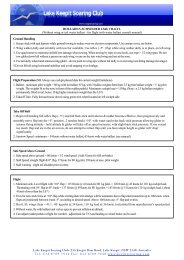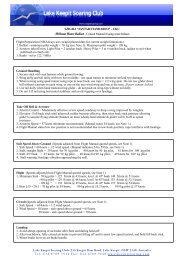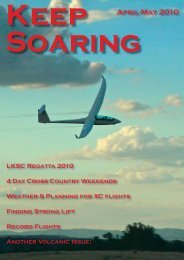Flying the Morning Glory Dust Devil Dash Hitting the Silk New ...
Flying the Morning Glory Dust Devil Dash Hitting the Silk New ...
Flying the Morning Glory Dust Devil Dash Hitting the Silk New ...
Create successful ePaper yourself
Turn your PDF publications into a flip-book with our unique Google optimized e-Paper software.
<strong>Hitting</strong> <strong>the</strong> <strong>Silk</strong><br />
If you need to pull two levers, lower your head as much as<br />
possible when jettisoning <strong>the</strong> canopy. Use this head-down time<br />
to look at <strong>the</strong> seat belt harness release.<br />
There’s no guarantee that <strong>the</strong> canopy will fly off by itself.<br />
The pilot should be prepared to push hard upwards against <strong>the</strong><br />
acrylic to force <strong>the</strong> canopy off <strong>the</strong> cockpit. Once <strong>the</strong> canopy has<br />
been released, things inside <strong>the</strong> cockpit may get fairly chaotic<br />
because of <strong>the</strong> force of <strong>the</strong> slipstream.<br />
Next, release <strong>the</strong> set belt harness.<br />
Don’t just feel for <strong>the</strong> harness release, look at it before<br />
operating! If you are lucky, <strong>the</strong> harness will release easily and<br />
you can climb out of <strong>the</strong> glider. Assuming <strong>the</strong> glider is flying<br />
straight and level at <strong>the</strong> time.<br />
Most likely <strong>the</strong> glider will be doing anything o<strong>the</strong>r than flying<br />
straight and level and you will release <strong>the</strong> harness and find it<br />
difficult or close to impossible to push or pull yourself up and<br />
out of <strong>the</strong> cockpit. If <strong>the</strong> glider has entered a spiral dive, <strong>the</strong> G<br />
force may quickly and easily exceed 2 Gs. That’s only <strong>the</strong> G force<br />
in a 60º bank and it’s going to double your body weight.<br />
It’s probably not possible to simulate this in an actual glider<br />
cockpit, but next time you are at <strong>the</strong> club, lie down on your back<br />
on <strong>the</strong> ground and get a friend of similar size to lie down on top<br />
of you. (Let people know what you are doing first!) Now, put<br />
your hands down on <strong>the</strong> ground ei<strong>the</strong>r side of you and try and<br />
push <strong>the</strong> two of you up far enough to clear a notional cockpit<br />
side.<br />
Many pilots who have had to exit a glider have found it<br />
very hard and it may take several attempts and require almost<br />
superhuman strength. Don’t give up! The chaotic motion of <strong>the</strong><br />
sailplane may mean that <strong>the</strong> next time you try, you will succeed.<br />
The pilot and writer Jochen Ewald has frequently commented<br />
on <strong>the</strong> need for small bumps or hollows to be put in a cockpit<br />
floor to give a pilot a place to dig <strong>the</strong>ir heels in and lever<br />
<strong>the</strong>mselves up. Probably this is something which can be easily<br />
retrofitted to glider cockpits.<br />
If <strong>the</strong> sailplane you are flying is an SLG, this whole procedure<br />
may have to be modified. If <strong>the</strong> engine is extended or running, if<br />
at all possible, it should be stopped and retracted before bailing<br />
out. Use <strong>the</strong> emergency or manual override to retract <strong>the</strong> engine.<br />
If <strong>the</strong> propellor is still turning, don’t wait, it will stop when it hits<br />
<strong>the</strong> engine bay doors. Hopefully <strong>the</strong> manual retract switch is self<br />
latching, so as soon as you have thrown <strong>the</strong> switch to start <strong>the</strong><br />
retraction, you can get on with <strong>the</strong> rest of <strong>the</strong> bail-out process.<br />
October November 2009<br />
As soon as you are clear of <strong>the</strong> cockpit, pull <strong>the</strong> rip cord<br />
and you have survived!<br />
Well no… it is not so easy and you are by no means safe yet.<br />
A lot of things can go wrong at this stage, if <strong>the</strong>y have not already<br />
done so.<br />
You may get <strong>the</strong> seat belt harness and parachute harness tangled<br />
up.<br />
There may be all sorts of hang-ups when exiting <strong>the</strong> cockpit<br />
caused by water drinking tubes, “pilot relief” tubes, oxygen<br />
and headphones. The results of having an external ca<strong>the</strong>ter<br />
hook up inside <strong>the</strong> cockpit scarcely bear thinking about.<br />
You may get your feet caught in <strong>the</strong> pedals. If you are lucky,<br />
you’ll only lose a shoe.<br />
You may have your parachute done up too loose and break an<br />
arm when <strong>the</strong> chute opens.<br />
But let’s say that you get out safely and it is time to pull<br />
your parachute rip cord. Look at <strong>the</strong> rip cord handle, reach out<br />
quickly with both hands if possible. If you can only get one hand<br />
on <strong>the</strong> rip cord handle, your o<strong>the</strong>r hand can be used to stabilise<br />
<strong>the</strong> hand on <strong>the</strong> rip cord. The rip cord should <strong>the</strong>n be firmly<br />
pulled all <strong>the</strong> way out with a circular motion across <strong>the</strong> body.<br />
Practice looking relaxed while you pull <strong>the</strong> rip cord.<br />
Possibly <strong>the</strong> biggest impediment to pulling <strong>the</strong> rip cord is<br />
going to be tumbling and <strong>the</strong> second, <strong>the</strong> violence of <strong>the</strong> airflow.<br />
If you start to tumble, <strong>the</strong>n G forces may build up so fast that you<br />
are unable to bring your arms back in towards your body to pull<br />
<strong>the</strong> rip cord.<br />
Keep Soaring October-November 2009 Page 30








